I’ve always had a bit of a fascination for cemeteries because they hold intriguing clues to the culture and history of an area. And perhaps I just enjoy walking with ghosts. 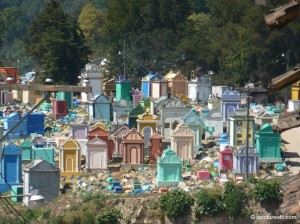
Los cementerios guatemaltecos promised to be of particular interest as they share the vibrant use of color seen elsewhere in the country – in the traditional dress (traje) of the indigenous Maya and in the deep pastels painted on the houses of the living. And if you have looked at photos of Guatemala, you might have already seen the iconic photos of the cemetery in Chichicastenango.
Convenient and cheap round trip shuttle tours to Chichicastenango are available from various starting points each Thursday and Sunday, the days of the big (tourist) market there. Some do this from Antigua, and others from Lake Atitlan. Strangely, almost none of those who go to the ‘must-see’ market in Chichicastenango bother to seek out the cemetery. The day I went, the only people I saw in the cemetery were those on the guided tours.
As lovely as the distant view is of the cemetery in Chichicastenango, up close it was less impressive than quite a few other cemeteries I explored closely in the Quiché region of Guatemala. Some of these I had the chance to explore properly, others I only glimpsed while in transit. But what the photos of the cemetery in Chichi did do for me was alert me to the fact that Guatemalan cemeteries are worthy of note and ought to be sought out whenever possible.
Guatemalan cemeteries are quite variable though they share some common traits. The more well to do families build little house-like mausoleums and often paint them in the same kinds of bright pastels that are also so popular for the houses of the living. The more urban the area, the fewer the in-ground graves. I was told that in-ground graves were quite impermanent – when they are no longer maintained and the marker falls, they are dug up and another body dropped in.
I found that the dates on the markers were all quite recent – something from the 1950s would be old, yet these areas have been so long settled. Some of the cemeteries were well attended and maintained with fresh flowers throughout and all the old removed and discarded. Others were weed-filled and most of the flower offerings brown and dried with sometimes what appeared to be years of old flowers left in place.
Antigua and the surrounding area
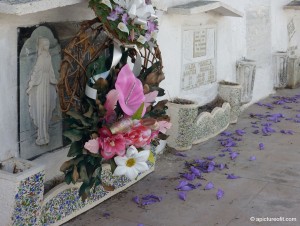 My survey of cemeteries included four in the Antigua area. One was in the city, one in the nearby urban area of Ciudad Vieja, one in a rural area high above the town and one in the pueblo of Santa Maria de Jesus high on the flanks of Volcán de Agua. The Antigua area has included several Guatemalan capitals. Before the arrival of the Spanish, various groups of Maya jousted among one another for power. The first capital established by the conquistadors (1524) was in Iximché, west of Lake Atitalan. In 1527 it was relocated to what was then called Guatemala City and is now known as Ciudad Vieja.
My survey of cemeteries included four in the Antigua area. One was in the city, one in the nearby urban area of Ciudad Vieja, one in a rural area high above the town and one in the pueblo of Santa Maria de Jesus high on the flanks of Volcán de Agua. The Antigua area has included several Guatemalan capitals. Before the arrival of the Spanish, various groups of Maya jousted among one another for power. The first capital established by the conquistadors (1524) was in Iximché, west of Lake Atitalan. In 1527 it was relocated to what was then called Guatemala City and is now known as Ciudad Vieja.
A devastating lahar from Volcán de Agua wiped out the town in 1541, and in 1543 the name Guatemala City was moved to what is now known as Antigua. This location, in turn, eventually proved to be unsafe as well. Earthquakes were an ongoing problem and in 1773 the city was hit by a major quake which made rubble of its many churches and official buildings. The next year the capital (and its name) was moved again, this time 45 kilometers to the east.
The following photos are from the Antigua area. The cemetery in Antigua has almost no in-ground burials. There are the usual individual mausoleums for well-to-do families, though in Antigua they are almost all white rather than painted in pretty colors.
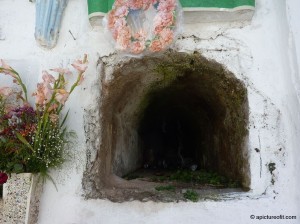 There are also group structures where the individual crypts are in layers like a small high-rise apartment. This crypt has been previously used and awaits a new occupant. These also appear to be relatively high rent, but most of the interments in Antigua were in small niches in walls covered with plaques. The difference between the latter two types are that the first allows interment of an intact body where the small niches would require cremation.
There are also group structures where the individual crypts are in layers like a small high-rise apartment. This crypt has been previously used and awaits a new occupant. These also appear to be relatively high rent, but most of the interments in Antigua were in small niches in walls covered with plaques. The difference between the latter two types are that the first allows interment of an intact body where the small niches would require cremation.
 The cemeteries are generally well maintained and the gravesites well tended. As long as there are surviving family, there will often be flowers – some fresh, and many artificial, hence longer lasting. This wall niche combined both, with fresh flowers on the right a few days old.
The cemeteries are generally well maintained and the gravesites well tended. As long as there are surviving family, there will often be flowers – some fresh, and many artificial, hence longer lasting. This wall niche combined both, with fresh flowers on the right a few days old.
Seven kilometers away, in Ciudad Vieja, the character of the cemetery was completely different. There were many family mausoleums, painted and decorated as is typical in Guatemala.
Though Ciudad Vieja is also an urban center, it has a more strongly indigenous character than the UNESCO Heritage City of Antigua. The main path through the cemetery is swept daily, with brooms made of bundled twigs.
This is one of the more stately of the family mausoleums, bearing wreaths for the many family members whose ashes are behind the locked iron gate.
 And to the right is one of the more typical small structures, brightly painted and hung with an assortment of wreaths.
And to the right is one of the more typical small structures, brightly painted and hung with an assortment of wreaths.
In Ciudad Vieja, many of the burials were in-ground and very well decorated. Notice also that the crosses marking the graves are typically of wood, and often marked only with paint. It is little wonder that the in-ground graves are so often quite ephemeral.
High on the shoulder of Volcán de Agua, above both Antigua and Ciudad Vieja, is the village of Santa Maria de Jesus. When you step off the local bus here, you’d better have both a warm jacket and either your Spanish or Kaqchiquel Maya language proficiency handy. You will have completely left the gringo trail behind.
This is the starting point for the hike up to the top of Volcán de Agua, and on the day I was here, so were hundreds of Scouts from all over Guatemala, ready to do this rigorous climb. Had I had warmer clothing, I’d have accepted their invitation to join them. This walk is notoriously unsafe to do alone (ladrones – robbers), and this would otherwise have been an ideal opportunity. But the day was quite cold and it would only get colder with the climb.
My usual pattern of aimless wandering in new places brought me quite accidentally, and fortuitously, to the local cemetery.
The tumbas here are painted in the vivid colors so typical in the Guatemalan highlands. Notice also that the main path is swept clean.
Wooden crosses, decorate the graves of the less affluent. Many of the graves still bear faded brown wreaths, some possibly from the previous Day of the Dead on November 1st. Some looked even older, as if the person who had been remembering the deceased was now gone as well.
Artificial flowers provide long lasting color to remember a loved one. Here some of the crosses are wood, but others appear to be of painted stucco.
Dark recently turned earth indicated a recent burial. In fact the date of death was only two days prior.
This last explored cemetery from the Antigua area was a tiny place located high on a hill in a rural area. I had arrived here to visit an organic farm which may eventually be the site of a restaurant. This is the view of Antigua from the garden. Ciudad Vieja is the urban area on the left rear of the photo.
And this is the tiny, overgrown cemetery adjacent to the garden.
It was a most atmospheric place, there high on the hill, in an area lightly peopled, scattered indigenous villages, hilltop crops – a cemetery nearly, but not, forgotten in time.
On from Antigua and its surroundings in the next segment – to San Marcos Lake Atitlan, Chichicastenango, to the Peten, Uspantán, Chajul, Acul, and Quiché.

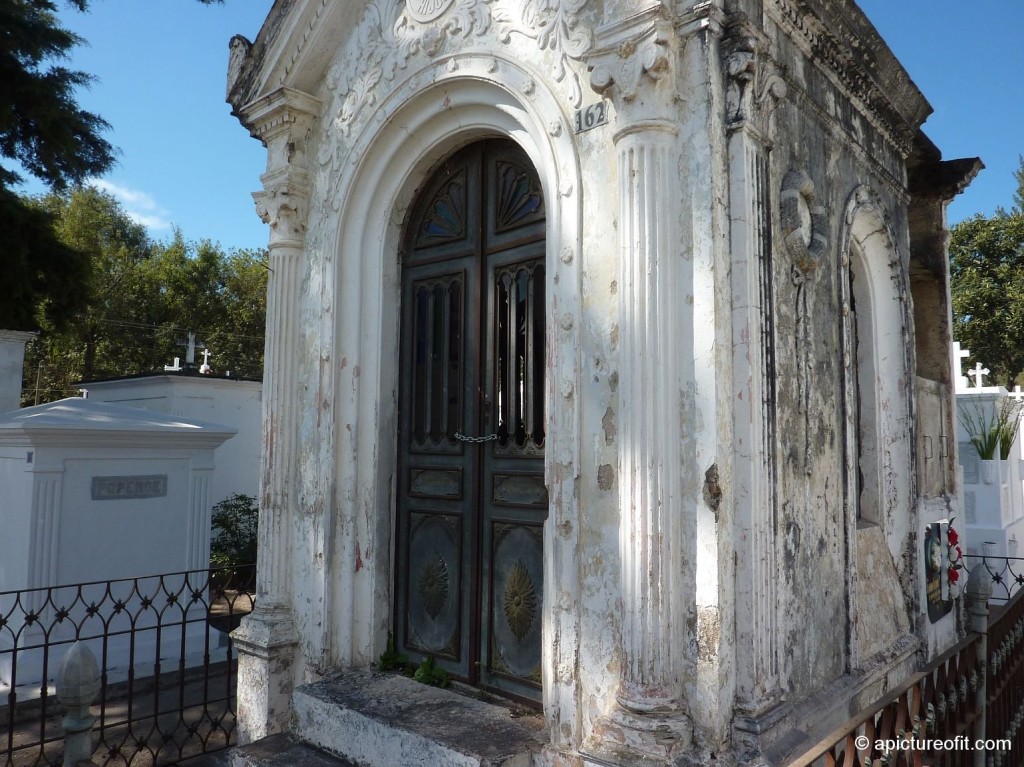


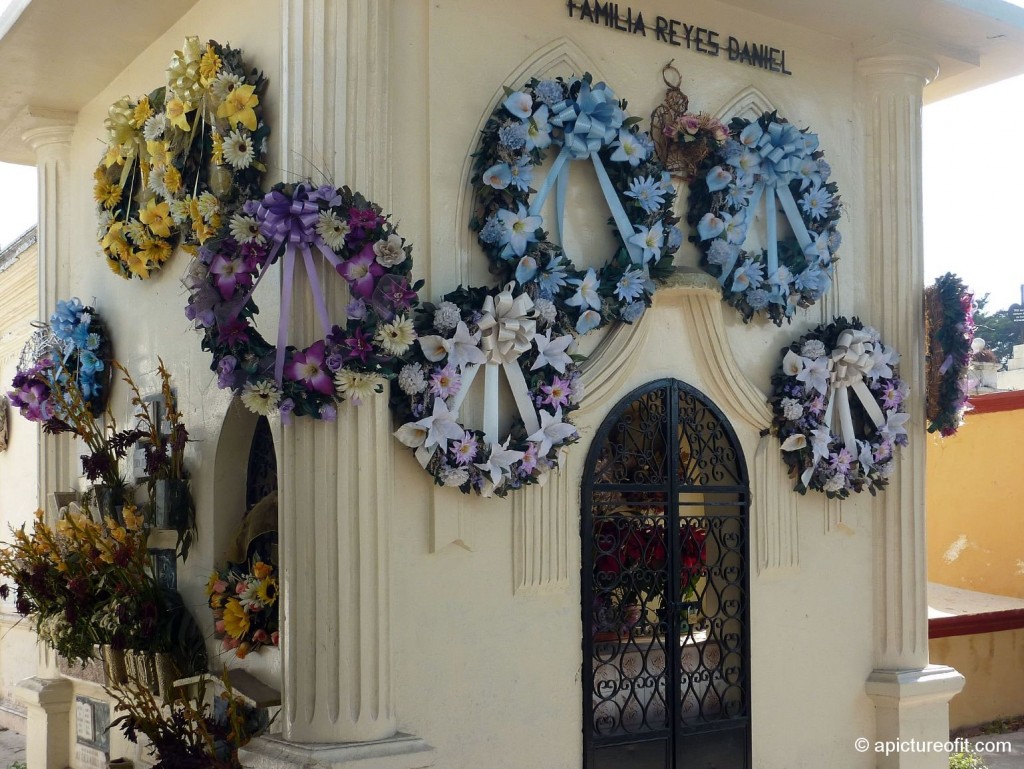



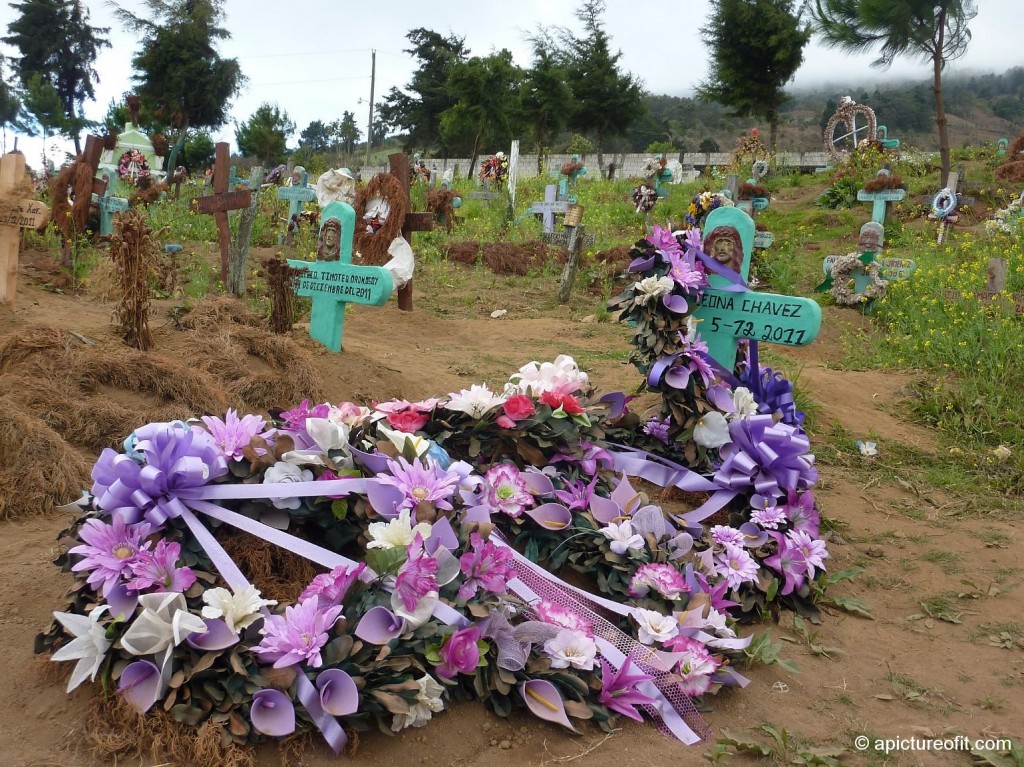



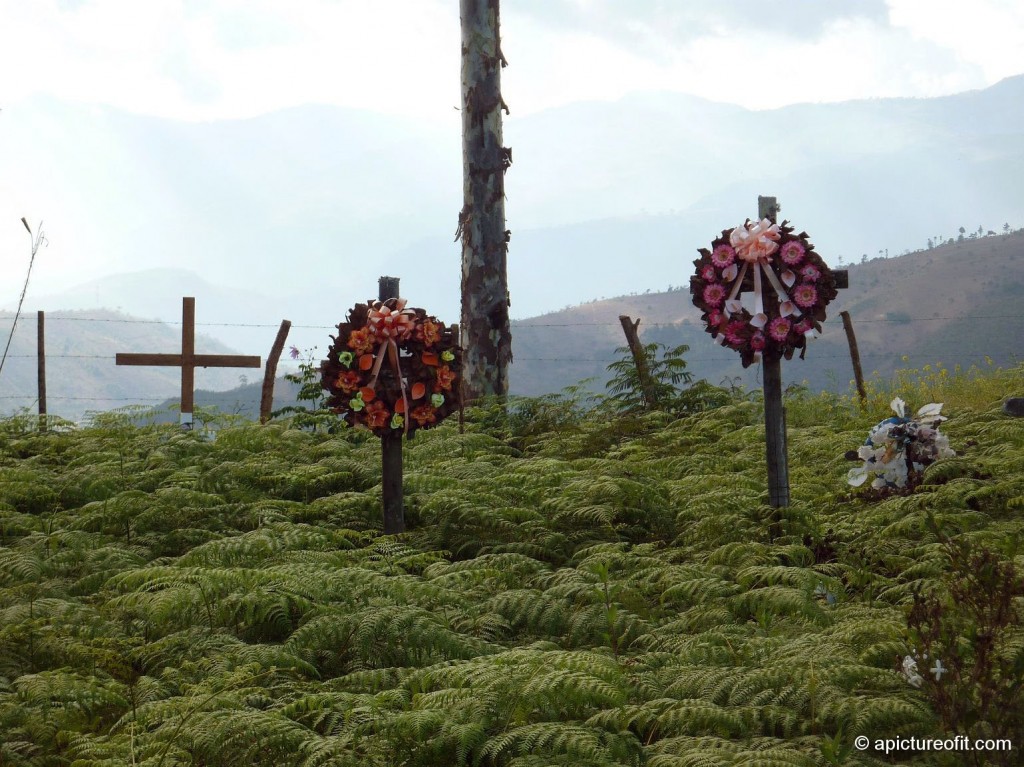
oh, i love to visit cemetery, but you have been to so many of them,great! btw ,how to spell theat word which I confused with baño:-) and you have been to Volcán de Agua ? I have seen it from the top of Volcán de Acatenango, amazing view of it with the sunset:)
Angela, I answered you elsewhere, but you finally remembered that the word was barrio. Quite funny, the amusing confusions that led to. I was on the flanks, the shoulder before the steepness increases, and the highest point you can usually drive to. The village of Santa Maria is visible from Acatenango where you spent the night, and also from Pacaya to the west of Agua. Really interesting place.
I was wondering if you could find where my husband is buried. I released his body to the family and I have never been there but would love to visit my husbands grave and put flowers in it. I just wish I had that chance. He’s from Pajapita Guatemala. Please help me find what cemetery he’s in. Thank you and appreciated. His full name is Ronaldo Benjamin Cardona Lopez.
Love Nichole Cardona Lopez
Nichole, I am so sorry, but I really can’t be of any help to you. Pajapita is toward the coast, out of Xela. I have not been in that region at all. I hope you have been able to discover some information from your husband’s family, or have perhaps been able to go there yourself.
You’ve captured the colors and spirit of Guatemala’s more rural cemeteries, which my recent trip to the country only left me opportunity to see at a distance. Your post will get me out to see them next time I’m in country. But I did have reason to visit the main public cemetery in Guatemala City – the extraordinary disparities in wealth as one walks the crypts from front to back (which overlooks the city’s infamous garbage dump) are also worth confronting and photographing. The back of that cemetery has many desecrated and vandalized graves, testament to the poverty that confronts so many in the surrounding neighborhoods.
Daniel, thank you for your very interesting comments on the main cemetery in Guatemala City. Yes, definitely do make a point to explore some of the rural cemeteries if you get the chance. They are so varied and so fascinating.
Hi, Christine I would like to see if you can help me find my son’s grandpa all I know he was buried in Guatemala city zona 3 I don’t know the cementary his name is Oscar Avalos Gonzalez and he died in 1971 April 4th please if you can help me I will appreciated thank you
Do you have any information or photos of the cemetery in peblo Nuevo Vinas , department of Santa Rosa ? My American brother died there Oct 1, 2015. What can you tell me of a typical burial of a foreigner with no money. Thank you
Darris, no I have not been to that area so have no photos. From what I can find online, all foreigners will be autopsied, and the body will be held at the morgue for 48 hours from the time of death. If not claimed by family or friends, it will then be dealt with as for any indigent Guatemalan. You would need to seek further information from the coroner or morgue in pueblo Nuevo Vinas. I am so sorry for your loss.